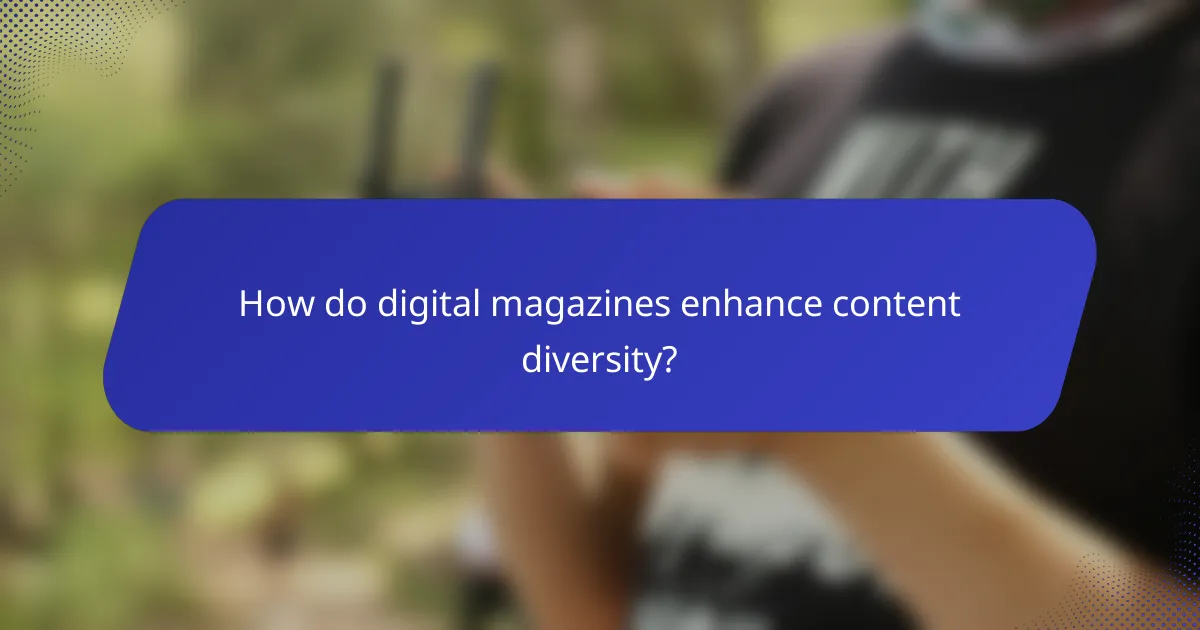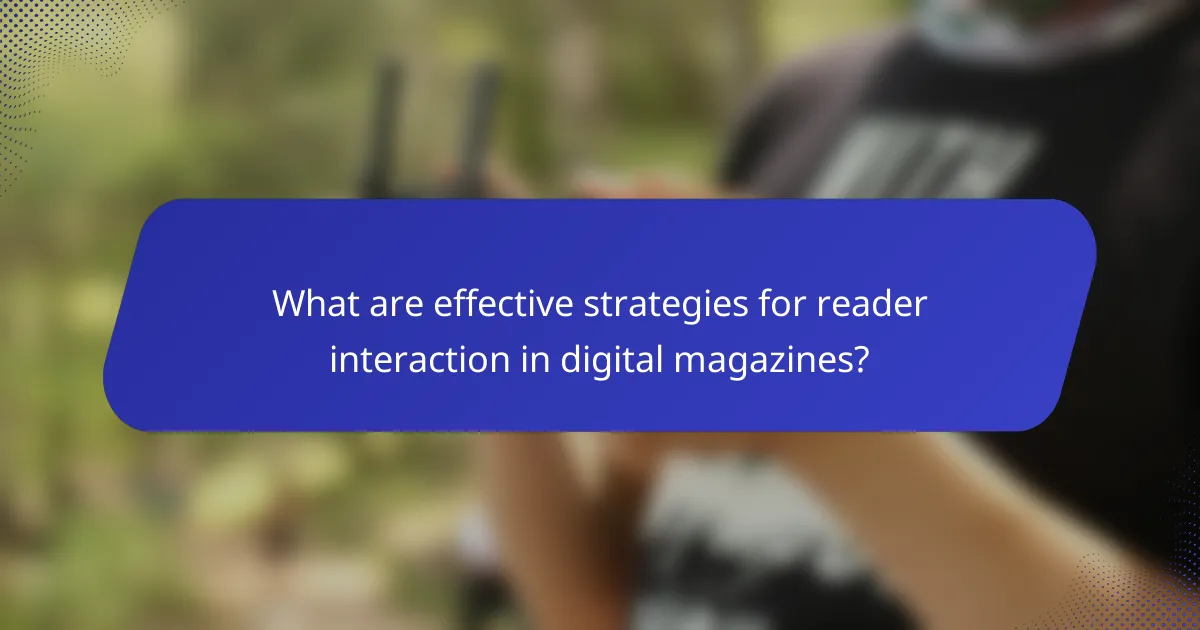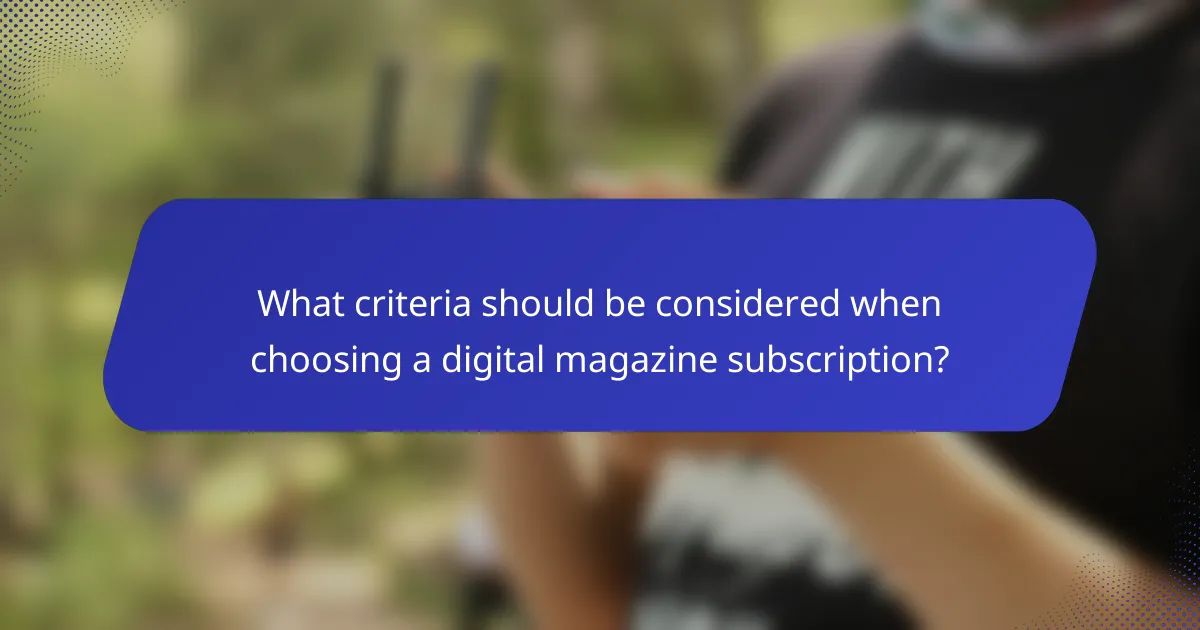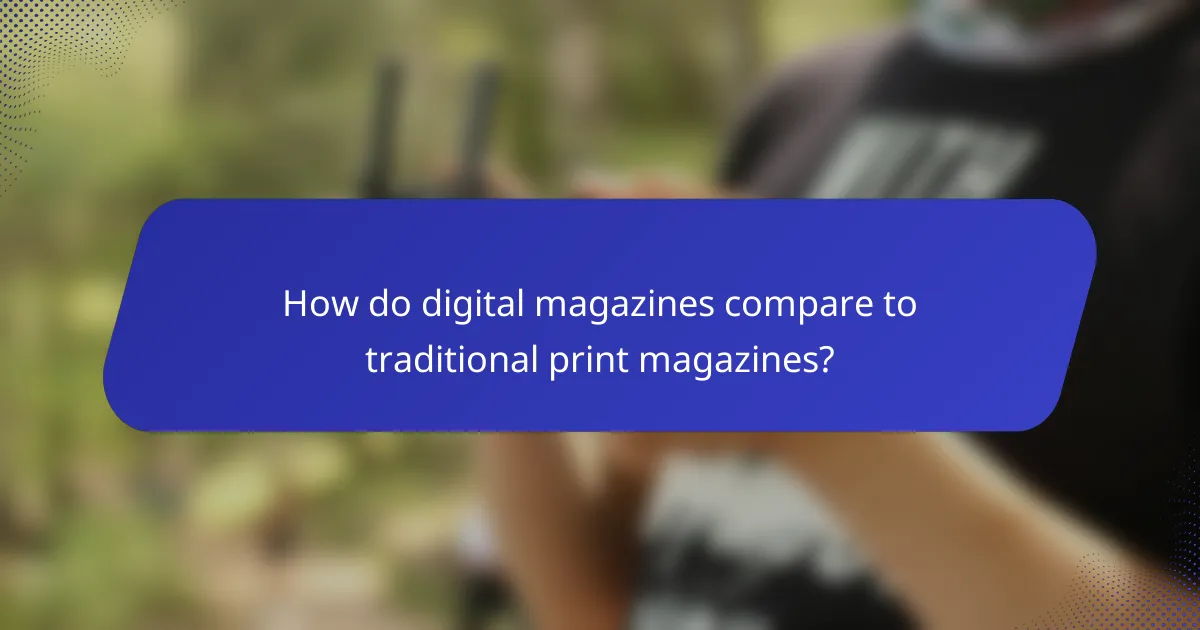Digital magazines have transformed the publishing landscape by offering diverse subscription models such as monthly, annual, and freemium options, each designed to meet varying reader preferences. By incorporating interactive elements and a range of content formats, these magazines enhance engagement and accessibility, creating a richer reading experience. Additionally, fostering reader interaction through comments, social media, and live events builds community and encourages valuable feedback.

What are the best subscription models for digital magazines in the UK?
The best subscription models for digital magazines in the UK include monthly, annual, freemium, pay-per-issue, and bundled subscriptions. Each model offers unique benefits and caters to different reader preferences, making it essential for publishers to choose the right approach to maximize engagement and revenue.
Monthly subscriptions
Monthly subscriptions allow readers to access content on a month-to-month basis, typically for a fixed fee. This model is appealing for those who prefer flexibility and want to avoid long-term commitments. Prices often range from £5 to £15 per month, depending on the magazine’s niche and content quality.
One key advantage is the ability to cancel anytime, which can attract more readers. However, publishers may face higher churn rates, requiring effective retention strategies to keep subscribers engaged.
Annual subscriptions
Annual subscriptions offer readers access to a full year’s worth of content for a single upfront payment, usually at a discounted rate compared to monthly plans. Prices can vary widely, often between £50 and £150, depending on the magazine’s prestige and content depth.
This model encourages reader loyalty and provides publishers with predictable revenue. However, it requires a strong value proposition to convince readers to commit for a longer period.
Freemium models
Freemium models provide basic access to content for free while offering premium features or exclusive content for a fee. This approach can attract a larger audience, as readers can sample the magazine before deciding to pay for additional content.
Publishers should ensure that the premium content is compelling enough to convert free users into paying subscribers. Balancing free and paid content is crucial to maintain interest without devaluing the subscription.
Pay-per-issue
Pay-per-issue models allow readers to purchase individual issues without a subscription commitment. This model is ideal for casual readers who may only be interested in specific topics or issues. Prices typically range from £2 to £5 per issue.
While this model can generate revenue from one-off purchases, it may not provide the same level of consistent income as subscription models. Publishers should promote upcoming issues effectively to encourage purchases.
Bundled subscriptions
Bundled subscriptions offer access to multiple magazines or digital publications for a single price, often providing significant savings compared to purchasing each title separately. This model can range from £10 to £30 per month, depending on the number of included titles.
Bundled subscriptions can enhance reader value and increase overall engagement. However, publishers must ensure that the bundled content is relevant and appealing to attract subscribers from various interests.

How do digital magazines enhance content diversity?
Digital magazines enhance content diversity by incorporating various formats and interactive elements that cater to different reader preferences. This approach allows for a richer reading experience, making content more engaging and accessible.
Multimedia integration
Multimedia integration in digital magazines includes the use of videos, audio clips, and interactive graphics alongside traditional text and images. This combination not only enriches the storytelling but also caters to different learning styles, allowing readers to choose how they consume information.
For example, a cooking magazine might feature video tutorials alongside written recipes, appealing to visual learners while providing step-by-step guidance. This variety can significantly enhance reader engagement and retention.
Interactive features
Interactive features such as quizzes, polls, and clickable infographics allow readers to engage actively with the content. These elements encourage participation and can provide personalized feedback, making the reading experience more immersive.
For instance, a travel magazine might include a poll asking readers about their favorite destinations, which can foster a sense of community and connection among readers. Such features can also help magazines gather valuable insights into reader preferences.
User-generated content
User-generated content (UGC) invites readers to contribute their own articles, photos, or reviews, further diversifying the magazine’s offerings. This approach not only enriches the content pool but also fosters a sense of ownership and loyalty among readers.
Magazines that feature UGC often see increased engagement, as readers are more likely to share their contributions on social media, promoting the magazine organically. Examples include lifestyle magazines that showcase reader-submitted fashion styles or travel experiences.
Specialized niches
Digital magazines can focus on specialized niches, catering to specific interests or communities that may be underserved by traditional publications. This specialization allows for deeper exploration of topics and can attract dedicated readerships.
For example, a magazine dedicated to urban gardening can provide tailored content, including expert tips, product reviews, and community stories, appealing to enthusiasts who seek in-depth knowledge. Such targeted content can build a loyal audience and enhance overall content diversity.

What are effective strategies for reader interaction in digital magazines?
Effective strategies for reader interaction in digital magazines include utilizing comment sections, engaging on social media, conducting surveys and polls, and hosting live events. These methods foster a sense of community and encourage feedback, enhancing the overall reader experience.
Comment sections
Comment sections allow readers to share their thoughts and engage in discussions about articles. This interaction can provide valuable insights into reader preferences and opinions. To maintain a positive environment, moderators should actively manage comments, encouraging constructive dialogue while addressing inappropriate content.
Encouraging authors to respond to comments can further enhance engagement, making readers feel valued and heard. Consider highlighting insightful comments to promote deeper discussions.
Social media engagement
Social media platforms are essential for promoting articles and interacting with readers. Sharing content on platforms like Facebook, Twitter, and Instagram can drive traffic to the magazine while allowing readers to comment and share their thoughts. Regularly posting updates and engaging with followers can build a loyal community.
Utilizing interactive features such as polls or Q&A sessions on social media can also boost engagement. Encourage readers to share their experiences or opinions related to the magazine’s content to create a more dynamic interaction.
Surveys and polls
Surveys and polls are effective tools for gathering reader feedback and preferences. They can be integrated into articles or sent via email to subscribers, allowing readers to express their opinions on various topics. Keep surveys concise to encourage participation, aiming for a completion time of just a few minutes.
Offering incentives, such as discounts on subscriptions or entries into a giveaway, can increase response rates. Analyze the results to tailor content to reader interests and improve overall satisfaction.
Live events and webinars
Hosting live events and webinars provides an interactive platform for readers to engage directly with authors and experts. These events can cover relevant topics, allowing for real-time questions and discussions. Promote these events through various channels to maximize attendance.
Consider recording sessions for later viewing, providing additional value to those who cannot attend live. Follow up with attendees through email to gather feedback and maintain engagement after the event.

What criteria should be considered when choosing a digital magazine subscription?
When selecting a digital magazine subscription, consider factors such as content quality, pricing, reader feedback, and accessibility features. These elements will help ensure that the subscription meets your interests and needs effectively.
Content quality
Content quality is crucial when evaluating a digital magazine subscription. Look for publications that offer well-researched articles, engaging visuals, and a variety of topics that align with your interests. High-quality content often reflects the expertise of the writers and the reputation of the magazine.
Check if the magazine provides exclusive features, such as interviews with industry leaders or in-depth analyses of current events. Subscriptions that offer diverse content types, including videos and interactive elements, can enhance your reading experience.
Price comparison
Price comparison is essential to ensure you get value for your money. Digital magazine subscriptions can vary widely, typically ranging from a few dollars to over twenty dollars per month. Compare subscription plans across different magazines to identify which offers the best features for the price.
Consider any promotional offers or bundled subscriptions that may provide additional savings. Some magazines offer discounts for annual subscriptions, which can lower the overall cost significantly.
Reader reviews
Reader reviews can provide insight into the overall satisfaction of current subscribers. Look for feedback on platforms like social media or review websites to gauge the magazine’s strengths and weaknesses. Pay attention to comments about content relevance, user experience, and customer service.
High ratings and positive testimonials often indicate a reliable subscription, while consistent complaints may signal potential issues. Use this information to make an informed decision about which magazine to choose.
Accessibility features
Accessibility features are important for ensuring that all readers can enjoy the content. Check if the digital magazine offers options such as text resizing, audio versions of articles, or compatibility with screen readers. These features can enhance the reading experience for individuals with disabilities.
Additionally, consider whether the magazine is available on multiple devices, including smartphones, tablets, and computers. A flexible reading platform can improve accessibility and convenience for users.

How do digital magazines compare to traditional print magazines?
Digital magazines offer distinct advantages over traditional print magazines, primarily in terms of accessibility and interactivity. Readers can access a wide range of content instantly on various devices, while print magazines often require physical distribution and storage.
Cost-effectiveness
Digital magazines typically have lower production and distribution costs compared to print magazines. This allows publishers to offer subscriptions at more affordable prices, often ranging from a few dollars to around twenty dollars per month, depending on the content and features offered.
Additionally, readers can save on costs associated with printing and shipping. For example, a digital subscription eliminates the need for physical copies, which can be particularly beneficial for avid readers who consume multiple publications.
Environmental impact
Digital magazines have a significantly lower environmental impact than traditional print magazines. The production of print magazines involves paper, ink, and transportation, all of which contribute to deforestation and carbon emissions. In contrast, digital formats reduce the need for these resources.
Choosing digital over print can help decrease waste and promote sustainability. Readers concerned about their ecological footprint may prefer digital subscriptions, as they support a more environmentally friendly approach to media consumption.
